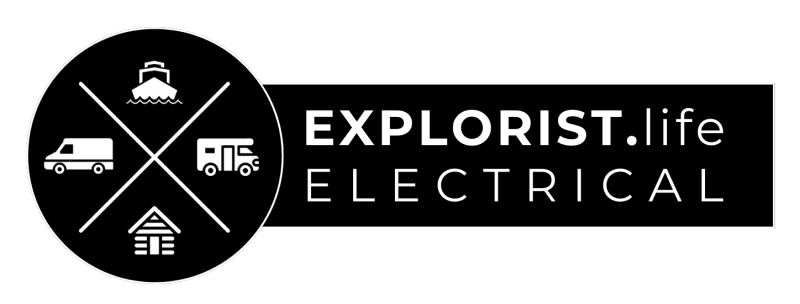
If you need to connect wire smaller than 6 AWG to a component, you’re going to use a ring terminal, and teaching you the correct way to crimp these is exactly what we are going to cover here in lesson #6 of this Wire Terminals playlist. My name is Nate, and welcome to the EXPLORIST.life Mobile, Marine, and Off-Grid Electrical Academy.
Now, I’ve already talked about how to cut wire, how to strip wire, and how to use heat shrink back in lessons 4.2 – 4.4 of this academy, so in this lesson, I’m going to assume you already know how to do that and only talk about crimping.

Ring Terminals 101- VIDEO

What Crimpers are best for Insulated Terminals?
Once you have the correct ring terminal size for the wire size and the stud size of the equipment, we need a crimper.
Insulated terminal crimpers look like this; and the most important part is how the jaws of the crimper look.

Notice how the jaws of the crimper are smooth on each side. This is so that when we crimp the terminal, the insulation isn’t damaged like it would be if we were to use an open barrel crimper that has a little tooth in the middle.

These crimpers are pretty symmetrical, so there’s not really a way to get this backwards.
I have two crimpers here, and the only difference is the size of terminals that they can crimp.
The first one has a space for 20-18 AWG, 16-14 AWG, and 12-10 AWG.
This other one accepts 8 AWG and 6 AWG terminals

Some crimpers are labeled, others are color coordinated. Some are neither. I just know what sizes of wires my crimpers are appropriate for, and I can always look back at the instruction manual for each of them as a reminder if needed.
They both ratchet and will only release when they’ve been fully squeezed and therefore properly crimped.
How to Crimp an Insulated Terminal
I’ve already pre-stripped some insulation from this 16 AWG. I stripped back the same length as the metal barrel of the terminal.
Put the terminal in its appropriate space on the crimper. 16 AWG Terminal into the 16-14 AWG space on these crimpers.

Put the wire into the terminal, making sure that the wire actually goes into the metal part of the terminal.
Squeeze the handles of the crimper until they release.

Alternatively, you could put the terminal on the wire – Terminal into the crimpers – and squeeze. Either way. Try both ways and see which works best for you.
Once it’s crimped, give the terminal a good pull to make sure it doesn’t come loose. Here is a table with values for how much force you should be able to apply to the terminal before it comes loose; and it’s truly a lot.

Most of us won’t have the means to measure this; just do your best and make good judgment calls here.
The larger crimpers are the exact same process, just with bigger terminals for bigger wire, and you’ll need a bit more grip strength to crimp these.
Some insulated terminals actually have pre-installed heat shrink on them, which is super nice. If this is the case for the terminals you’re using, hit ‘em with a heat gun to close them up nice and tight.

Standard nylon insulated ring terminals typically do not receive additional heat shrink.
Can a non-insulated wire crimper be used for insulated terminals?
Part of doing this stuff yourself means buying the right tools for the job, but here’s what I’ve noticed:
- For wire smaller than 10 AWG; non-insulated crimpers cannot be used for insulated terminals because they simply don’t fit into the crimper and it damages the insulation.
- For larger ring terminals like 6 AWG; you ‘can’ use the big TEMCO crimper like we use for bigger wire lugs, you just have to open the dial up a bit to accommodate the extra insulation. I will say, though, that there is a bigger chance of damaging the insulation of the terminal like this and if you damage the terminal, you have to scrap it and try again; so be careful; or just buy the tool that’s designed for the job.
Conclusion
Now we are going to be putting ring terminals on a lot of wires throughout the rest of this academy, so be sure to bookmark this lesson for future reference and come back to it if you need a refresher because going forward, I’ll just assume that you now know how to crimp a ring terminal.
